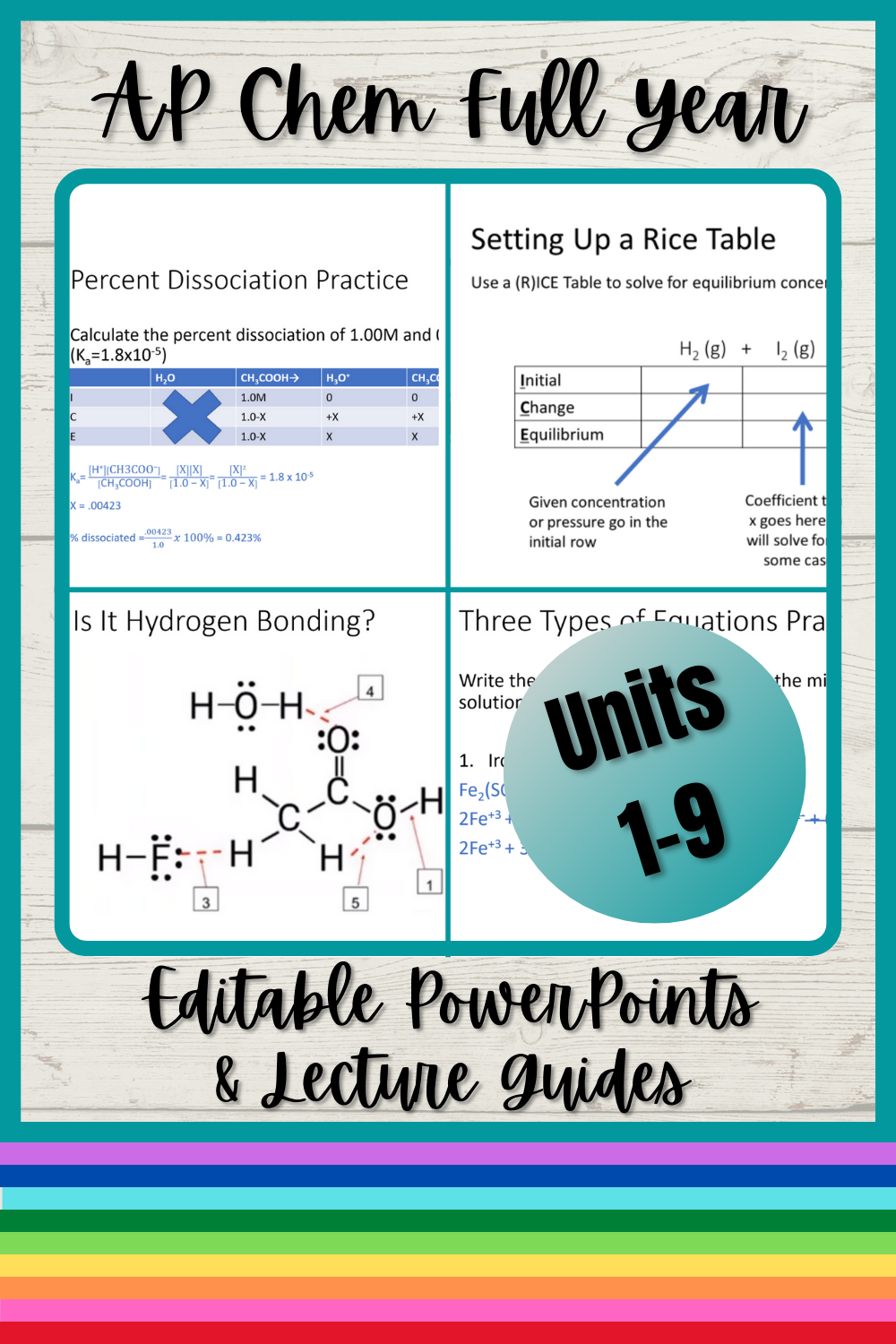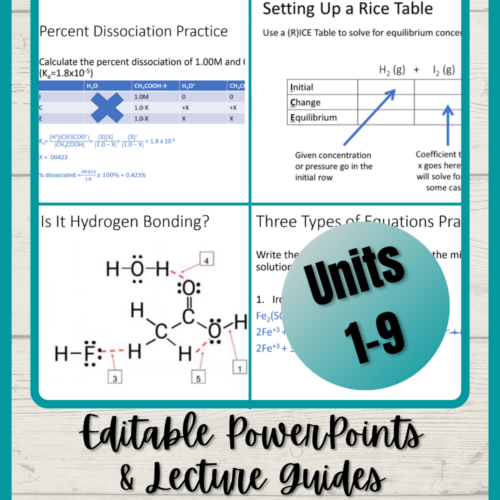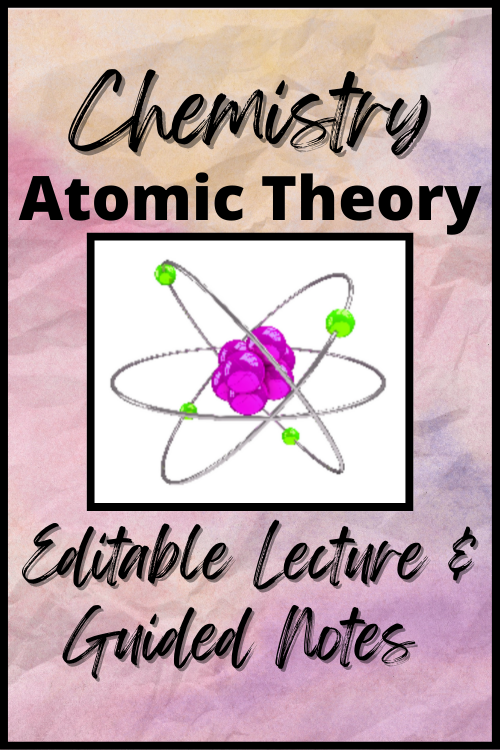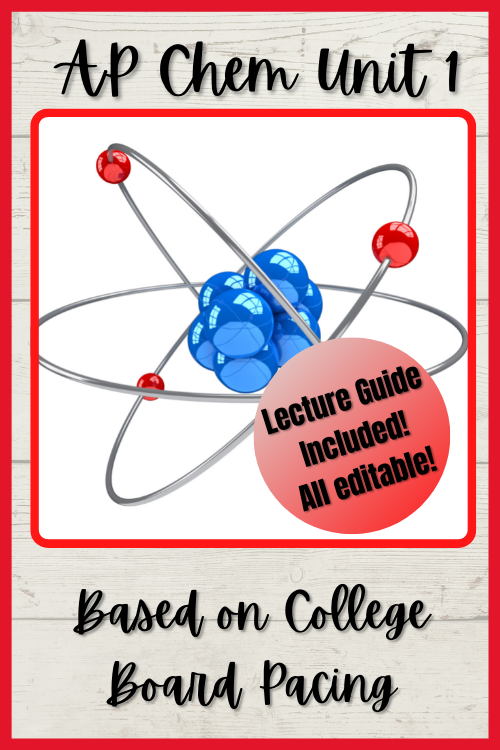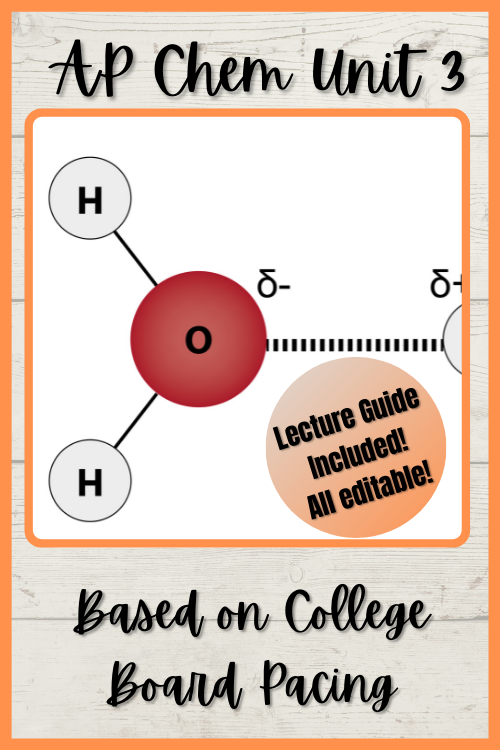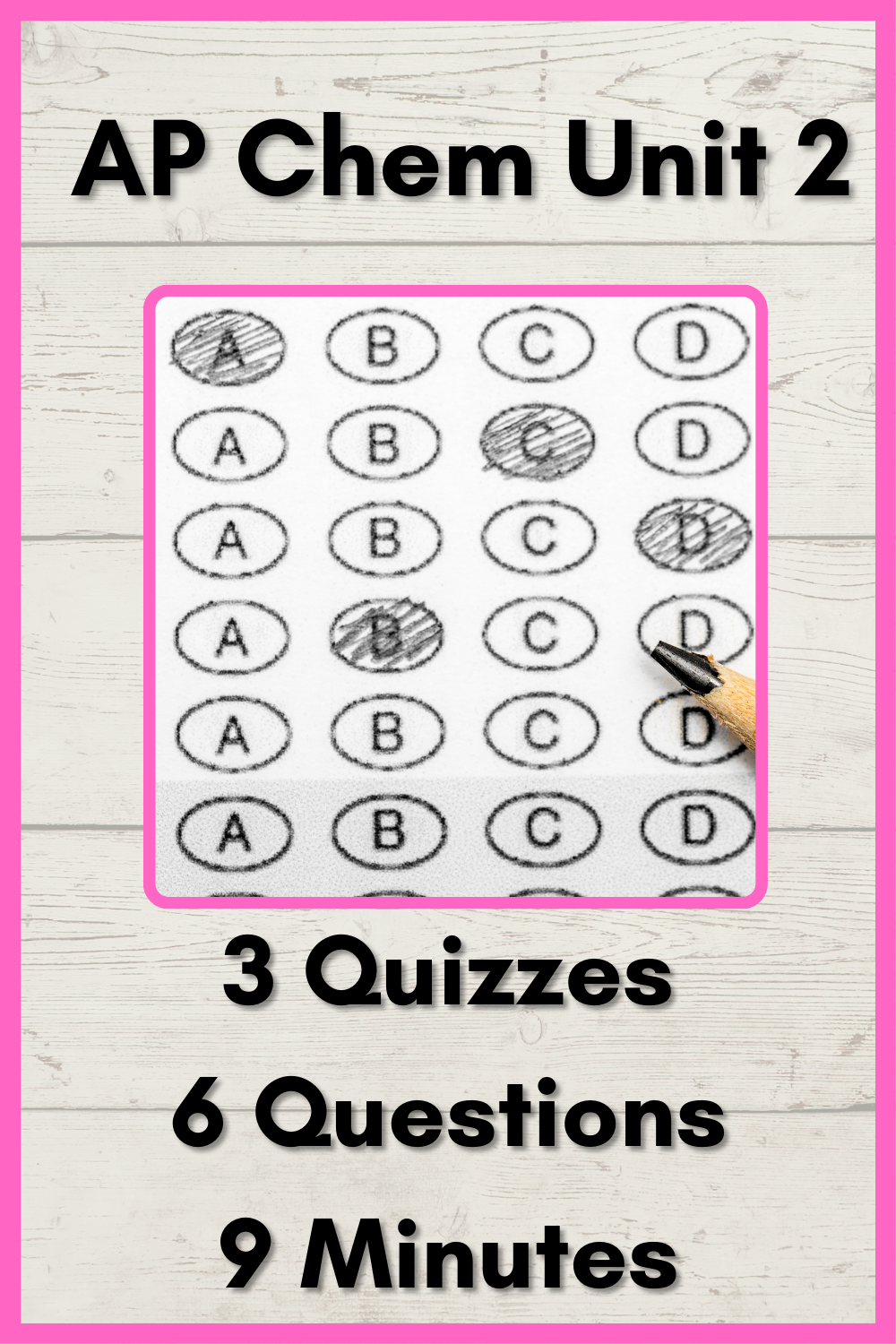Details
Pages
99+ Pages
Subject
Science, Chemistry
Languages
English
Grade
10th, 11th, 12th, Adult Ed, Higher Ed
Resource Type
Assessments, Lectures, Lesson Plans
Product
Digital
Description
This Resource is provided in both a Microsoft Word and a Microsoft PowerPoint document. Please make sure that your computer can accommodate this resource before purchasing.
This resource includes a PowerPoint and lecture guide for each of the 9 units for the entire year totaling over 1,280 slides. The topics are in accordance with the College Board Recommended Pacing(Please see topics below). AP questions and practice are embedded within each sub unit. Answers and explanations are included on either the slide or in the notes section of the PowerPoint. Both the lecture guide and PowerPoint are editable.
Unit 1:
1.1 Moles and Molar Mass (slides 2-12 )
1.2 Mass Spectroscopy of Elements (slides 15-25)
1.3 Elemental Composition of Pure Substances (slides 26-51)
1.4 Composition of Mixtures (slides 52-58)
1.5 Atomic Structure and Electron Configuration (slides 59-84)
1.7 Periodic Trends (slides 85-110)
1.6 Photoelectron Spectroscopy (slides 111-122)
1.8 Valence Electrons and Ionic Compounds (slides 123-126)
Unit 2:
2.1 Types of Chemical Bonds (slides 2-15)
2.2 Intramolecular Force and Potential Energy (slides 16-27)
2.3 Structure of Ionic Compounds (slides 28-31)
2.4 Structure of Metals and Alloys (slides 32-37)
2.5 Lewis Diagrams (slides 38-46)
2.6 Resonance and Formal Charge (slides 47-54)
2.7 VSEPR and Bond Hybridization (slides 55-76)
Unit 3:
3.1 Intermolecular Forces (slides 2-21)
3.2 Properties of Solids (slides 22-37)
3.3 Solids, Liquids, and Gases (slides 38-40)
3.4 Ideal Gas Law (slides 41-55)
3.5 Kinetic Molecular Theory (slides 56-59)
3.6 Deviation from Ideal Gas Law (slides 60-61)
3.7 Solutions and Mixtures (slides 62-65)
3.8 Representations of Solutions (slides 66-70)
3.9 Separation of Solutions and Mixtures (slides 71-76)
3.10 Solubility (slides 77-81)
3.11 Spectroscopy and the Electromagnetic Spectrum (slides 82-83)
3.12 Photoelectric Effect (slides 84-92)
3.13 Beer-Lambert Law (slides 93-101)
Unit 4:
4.1 Introduction for Reactions (slides 2-7)
4.2 Net Ionic Equations (slides 8-23)
4.3 Representations of Reactions (slides 24-29)
4.4 Physical and Chemical Changes (slides 30-37)
4.5 Stoichiometry (slides 38-60)
4.6 Introduction to Titration (slides 61-73)
4.7 Types of Chemical Reactions (slides 74-98)
4.8 Introduction to Acid-Base Reactions (slides 99-103)
4.9 Oxidation-Reduction (Redox) Reaction (slides 104-120)
Unit 5: Kinetics
5.1 Reaction Rates (slides 2-11)
5.2Introduction to Rate Law (slides 12-32)
5.3Concentration to Rate Law (slides 33-49)
5.4 Elementary Reactions & 5.7 Introduction to Reaction Mechanism (slides 50-59)
5.5 Collision Model (slides 60-65)
5.6 Reaction Energy Profile (slides 66-70)
5.8 Reaction Mechanism and Rate Law (slides 71-79)
5.9 Steady-State Approximation (slides 80-89)
5.10 Multistep Reaction Energy Profile (slides 90-101)
5.11 Catalysis (slides 102-108)
Unit 6:
Review Questions (slides 2-11)
6.1 Endothermic and Exothermic Processes (slides 12-26)
6.2 Energy Diagrams (slides 27-32)
6.3 Heat Transfer and Thermal Equilibrium (slides 33-39)
6.4 Heat Capacity and Calorimetry (slides 40-61)
6.5 Energy of Phase Changes (slides 62-71)
6.6 Introduction to Enthalpy of Reaction (slides 72-81)
6.7 Bond Enthalpies (slides 82 - 90)
6.8 Enthalpy of Formation (slides 91 - 101)
6.9 Hess's Law (slides 102-109)
Unit 7:
Review Questions (slides 2-11)
7.1 Introduction to Equilibrium (slides 12-18)
7.2 Direction of Reversible Reactions (slides 18-25)
7.3 Reaction Quotient and Equilibrium Constant (slides 26-41)
7.4 Calculating the Equilibrium Constant (slides 42-55)
7.5 Magnitude of the Equilibrium Constant (slides 56-63)
7.6 Properties of Equilibrium Constant (slides 64-76)
7.7 Calculating Equilibrium Concentrations (slides 77-104)
7.8 Representations of Equilibrium (slides 105-120)
7.9 Introduction to Le Chatelier's Principle (slides 121-156)
7.10 Reaction Quotient and Le Chatelier's Principle (slides 157-162)
7.11 Introduction to Solubility Equilibria (slides 163-191)
7.12 Common-Ion Effect (slides 192-207)
7.13 pH and Solubility (slides 208-217)
7.14 Free Energy of Dissolution (slides 218-226)
Unit 8:
Review (slides 2-7)
8.1 Introduction to Acids and Bases (slides 8-30)
8.2 pH and pOH of Strong Acids and Strong Bases (slides 31-47)
8.3 Weak Acid and Base Equilibria (slides 48-104)
8.4 Acid-Base Reactions and Buffers (slides 105-170)
8.5 Acid-Base Titrations (slides 171-187)
8.6 Molecular Structure of Acids and Bases (slides 188-198)
8.7 pH and pKa (slides 199-212)
8.8 Properties of Buffers (slides 213-221)
8.9 Henderson-Hasselbalch Equation (slides 222-237)
8.10 Buffer Capacity (slides 238-252)
Unit 9:
Review (slides 2-7)
9.1 Introduction to Entropy (slides 8-15)
9.2 Absolute Entropy and Entropy Change (slides 16-22)
9.3 Gibbs Free Energy and Thermodynamic Favorability (slides 23-49)
9.4 Thermodynamic and Kinetic Control (slides 50-55)
9.5 Free Energy and Equilibrium (slides 56-78)
9.6 Coupled Reactions (slides 79-86)
9.7 Galvanic (Voltaic) and Electrolytic Cell (slides 87-99)
9.8 Cell Potential and Free Energy (slides 100-129)
9.9 Cell Potential Under Nonstandard Conditions (slides 130-144)
9.10 Electrolysis and Faraday's Law (slides 145-163)
This Resource is provided in both a Microsoft Word and a Microsoft PowerPoint document. Please make sure that your computer can accommodate this resource before purchasing.
Licensing Terms:
By purchasing this product, you own a license for one teacher only for personal use in your classroom. Licenses are non-transferable, meaning they cannot be passed from one teacher to another. No part of this resource is to be shared with colleagues or used by an entire grade level, school, or district without purchasing the proper number of licenses.
This resource includes a PowerPoint and lecture guide for each of the 9 units for the entire year totaling over 1,280 slides. The topics are in accordance with the College Board Recommended Pacing(Please see topics below). AP questions and practice are embedded within each sub unit. Answers and explanations are included on either the slide or in the notes section of the PowerPoint. Both the lecture guide and PowerPoint are editable.
Unit 1:
1.1 Moles and Molar Mass (slides 2-12 )
1.2 Mass Spectroscopy of Elements (slides 15-25)
1.3 Elemental Composition of Pure Substances (slides 26-51)
1.4 Composition of Mixtures (slides 52-58)
1.5 Atomic Structure and Electron Configuration (slides 59-84)
1.7 Periodic Trends (slides 85-110)
1.6 Photoelectron Spectroscopy (slides 111-122)
1.8 Valence Electrons and Ionic Compounds (slides 123-126)
Unit 2:
2.1 Types of Chemical Bonds (slides 2-15)
2.2 Intramolecular Force and Potential Energy (slides 16-27)
2.3 Structure of Ionic Compounds (slides 28-31)
2.4 Structure of Metals and Alloys (slides 32-37)
2.5 Lewis Diagrams (slides 38-46)
2.6 Resonance and Formal Charge (slides 47-54)
2.7 VSEPR and Bond Hybridization (slides 55-76)
Unit 3:
3.1 Intermolecular Forces (slides 2-21)
3.2 Properties of Solids (slides 22-37)
3.3 Solids, Liquids, and Gases (slides 38-40)
3.4 Ideal Gas Law (slides 41-55)
3.5 Kinetic Molecular Theory (slides 56-59)
3.6 Deviation from Ideal Gas Law (slides 60-61)
3.7 Solutions and Mixtures (slides 62-65)
3.8 Representations of Solutions (slides 66-70)
3.9 Separation of Solutions and Mixtures (slides 71-76)
3.10 Solubility (slides 77-81)
3.11 Spectroscopy and the Electromagnetic Spectrum (slides 82-83)
3.12 Photoelectric Effect (slides 84-92)
3.13 Beer-Lambert Law (slides 93-101)
Unit 4:
4.1 Introduction for Reactions (slides 2-7)
4.2 Net Ionic Equations (slides 8-23)
4.3 Representations of Reactions (slides 24-29)
4.4 Physical and Chemical Changes (slides 30-37)
4.5 Stoichiometry (slides 38-60)
4.6 Introduction to Titration (slides 61-73)
4.7 Types of Chemical Reactions (slides 74-98)
4.8 Introduction to Acid-Base Reactions (slides 99-103)
4.9 Oxidation-Reduction (Redox) Reaction (slides 104-120)
Unit 5: Kinetics
5.1 Reaction Rates (slides 2-11)
5.2Introduction to Rate Law (slides 12-32)
5.3Concentration to Rate Law (slides 33-49)
5.4 Elementary Reactions & 5.7 Introduction to Reaction Mechanism (slides 50-59)
5.5 Collision Model (slides 60-65)
5.6 Reaction Energy Profile (slides 66-70)
5.8 Reaction Mechanism and Rate Law (slides 71-79)
5.9 Steady-State Approximation (slides 80-89)
5.10 Multistep Reaction Energy Profile (slides 90-101)
5.11 Catalysis (slides 102-108)
Unit 6:
Review Questions (slides 2-11)
6.1 Endothermic and Exothermic Processes (slides 12-26)
6.2 Energy Diagrams (slides 27-32)
6.3 Heat Transfer and Thermal Equilibrium (slides 33-39)
6.4 Heat Capacity and Calorimetry (slides 40-61)
6.5 Energy of Phase Changes (slides 62-71)
6.6 Introduction to Enthalpy of Reaction (slides 72-81)
6.7 Bond Enthalpies (slides 82 - 90)
6.8 Enthalpy of Formation (slides 91 - 101)
6.9 Hess's Law (slides 102-109)
Unit 7:
Review Questions (slides 2-11)
7.1 Introduction to Equilibrium (slides 12-18)
7.2 Direction of Reversible Reactions (slides 18-25)
7.3 Reaction Quotient and Equilibrium Constant (slides 26-41)
7.4 Calculating the Equilibrium Constant (slides 42-55)
7.5 Magnitude of the Equilibrium Constant (slides 56-63)
7.6 Properties of Equilibrium Constant (slides 64-76)
7.7 Calculating Equilibrium Concentrations (slides 77-104)
7.8 Representations of Equilibrium (slides 105-120)
7.9 Introduction to Le Chatelier's Principle (slides 121-156)
7.10 Reaction Quotient and Le Chatelier's Principle (slides 157-162)
7.11 Introduction to Solubility Equilibria (slides 163-191)
7.12 Common-Ion Effect (slides 192-207)
7.13 pH and Solubility (slides 208-217)
7.14 Free Energy of Dissolution (slides 218-226)
Unit 8:
Review (slides 2-7)
8.1 Introduction to Acids and Bases (slides 8-30)
8.2 pH and pOH of Strong Acids and Strong Bases (slides 31-47)
8.3 Weak Acid and Base Equilibria (slides 48-104)
8.4 Acid-Base Reactions and Buffers (slides 105-170)
8.5 Acid-Base Titrations (slides 171-187)
8.6 Molecular Structure of Acids and Bases (slides 188-198)
8.7 pH and pKa (slides 199-212)
8.8 Properties of Buffers (slides 213-221)
8.9 Henderson-Hasselbalch Equation (slides 222-237)
8.10 Buffer Capacity (slides 238-252)
Unit 9:
Review (slides 2-7)
9.1 Introduction to Entropy (slides 8-15)
9.2 Absolute Entropy and Entropy Change (slides 16-22)
9.3 Gibbs Free Energy and Thermodynamic Favorability (slides 23-49)
9.4 Thermodynamic and Kinetic Control (slides 50-55)
9.5 Free Energy and Equilibrium (slides 56-78)
9.6 Coupled Reactions (slides 79-86)
9.7 Galvanic (Voltaic) and Electrolytic Cell (slides 87-99)
9.8 Cell Potential and Free Energy (slides 100-129)
9.9 Cell Potential Under Nonstandard Conditions (slides 130-144)
9.10 Electrolysis and Faraday's Law (slides 145-163)
This Resource is provided in both a Microsoft Word and a Microsoft PowerPoint document. Please make sure that your computer can accommodate this resource before purchasing.
Licensing Terms:
By purchasing this product, you own a license for one teacher only for personal use in your classroom. Licenses are non-transferable, meaning they cannot be passed from one teacher to another. No part of this resource is to be shared with colleagues or used by an entire grade level, school, or district without purchasing the proper number of licenses.
This Resource is provided in both a Microsoft Word and a Microsoft PowerPoint document. Please make sure that your computer can accommodate this resource before purchasing. This resource includes a PowerPoint and lecture guide for each of the 9 units... more
